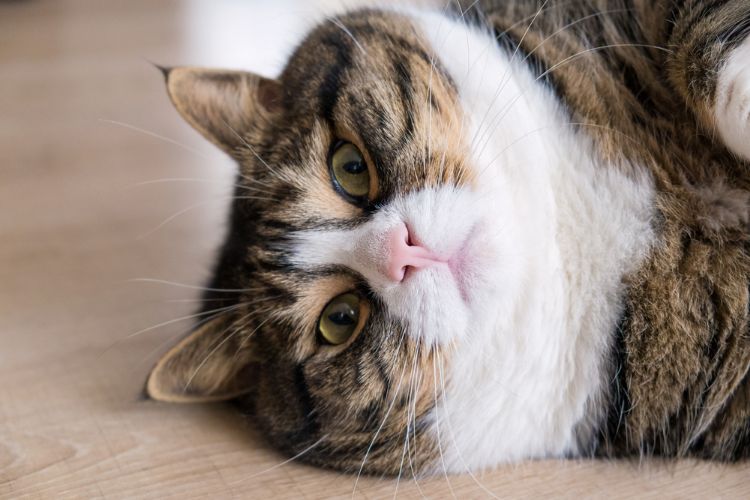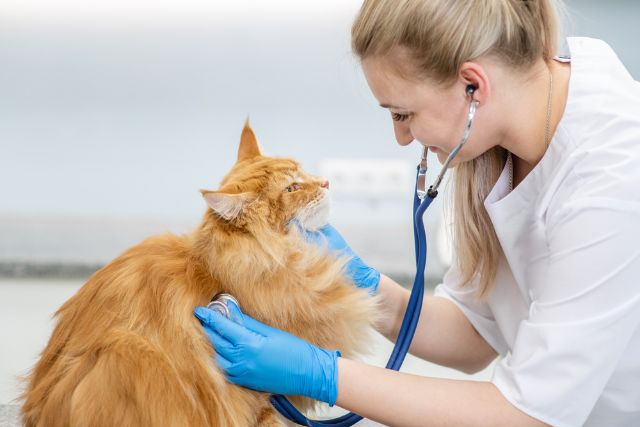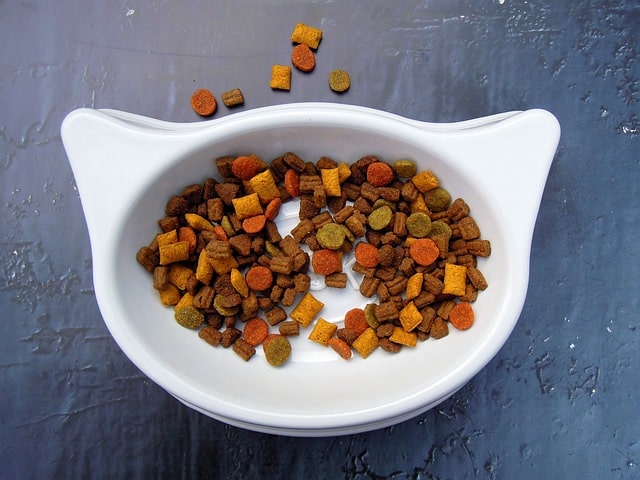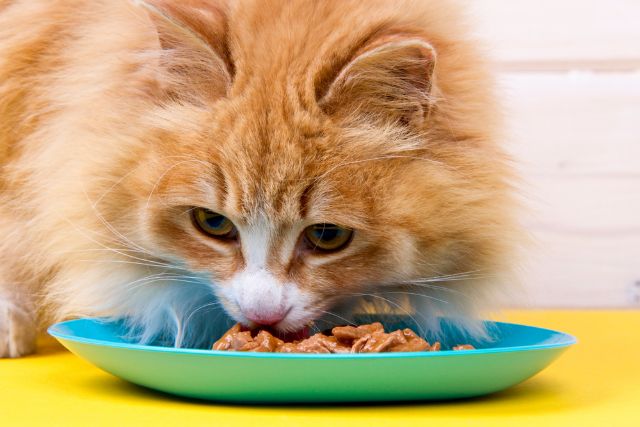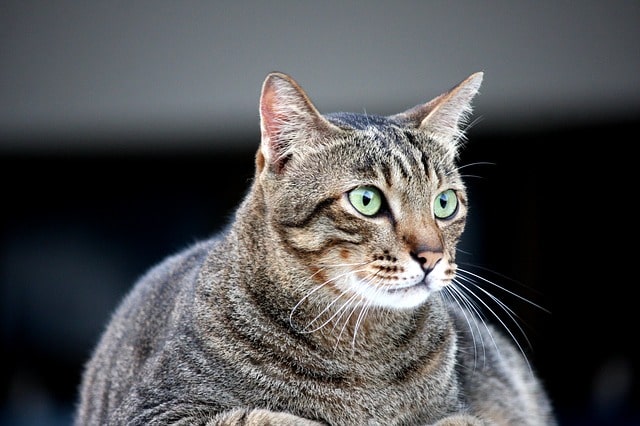Have you noticed that your cat has gained a few pounds? Or maybe your cat has been overweight for a while? It might be time to consider putting your cat on a diet.
You’re certainly not alone. Various studies have reported that more than half of pet cats may be overweight or obese and the problem appears to be getting worse over time.1 In fact, obesity is the most common nutrition-related problem in cats.2
While you may think an extra pound here or there isn’t a big deal, excess weight can compromise a cat’s health. It puts them at greater risk for a range of health problems including:3
- Cancer
- Diabetes mellitus
- Heart disease
- Hypertension
- Osteoarthritis
- Urinary bladder stones
- Anesthetic complications
- Hepatic lipidosis
- Skin problems
- Difficulty fighting infectious diseases
Putting an overweight cat on a diet will help them live better and longer. Keep reading to discover 7 key ways you can put your cat on a diet.
1. Devise a Weight Loss Plan With Your Vet
As you may already know from personal experience, trying to start a diet without a proper weight loss plan can make an already challenging task even more difficult. Fortunately, when it comes to devising a weight loss plan for your cat, you don’t need to go it alone.
Your vet has the expertise to put together an effective weight loss plan based on your cat’s unique health status, lifestyle, and needs. By involving your veterinarian, you will be able to help ensure that your cat loses weight in a safe and healthy manner.4
Your veterinarian can recommend an appropriate food, tell you exactly how much to feed at every meal, schedule weigh-ins to monitor the rate at which your cat is losing weight, and fine-tune your plan based on the results. Be sure to schedule a veterinary visit before putting your cat on a diet.
2. Measure Your Cat’s Food
If you’re in the habit of feeding your overweight cat however much food they seem to need, or worse yet, leaving food out all the time, it’s time to start measuring your cat’s food.5
Guesswork is a big no-no when it comes to how much food you should feed your cat, and cats will almost always overeat when they have unlimited, easy access to food.
To feed your cat properly, you will need to know how much food is ideal to give them in the first place. The best way to determine this is to ask your veterinarian. They will be able to determine the appropriate amount of food for your cat based on factors such as their health, weight, reproductive status, activity level, and so on.
3. Increase Meal Frequency
Photo courtesy: Pixabay Public Domain
So meals are better than free-feeding, but many well-meaning cat owners only offer their cats food twice a day. While it may be convenient, this feeding schedule makes it more likely that cats will overeat and feel hungrier later on.
So what is the alternative? Feeding multiple small meals throughout the day. By breaking their daily ration into small portions, you can help your cat to lose weight and reduce begging between meals.6 If you don’t have the time nor capacity to manually give them portioned meals throughout the day, consider buying an electronic cat feeder. Look for one that allows you to configure it to automatically dispense predetermined amounts of food throughout the day.
4. Feed Them Diet (Weight Management) Cat Food
Another way to put your cat on a diet is to feed them diet cat food. Diet cat food, also called weight management cat food, is specially formulated to help cats maintain a healthy weight. Most major brands of cat food have a diet cat food line, so you’ll have plenty to choose from.
Just make sure to carefully read the nutrition label of each diet cat food product, as some options are not all that nutritious or as calorie restricted as you might think. If you need advice on how to choose the right diet cat food for your cat (or whether it is even a good option for your cat), don’t hesitate to consult your vet. Foods that are only available with veterinary authorization (often called prescription foods) may be the best option for cats who need to lose large amounts of weight.
5. Switch to a Wet Food Only Diet
Canned cat foods have a much higher moisture content than do dry foods. The extra water has the same effect as drinking a large glass of water before a meal does for us. Cats eating wet food will feel full faster and stop eating sooner, which helps with weight loss.
Quality canned cat foods are also higher in protein and lower in carbohydrates than are equivalent dry foods. This better matches a cat’s nutritional needs and will also help with weight management.7
6. Reduce the Amount of Treats You Give
Is your go-to reward for your cat’s good behavior a tasty treat? While a small treat here or there may seem innocuous enough, the calories can really add up.
That is why you should only give treats in moderation; for weight loss they should only represent 5% or less of your cat’s daily food intake.8 And be sure to tell your veterinarian about the treats you give so the extra calories can be included when they calculate how much cat food you can offer each day.
7. Don’t Ignore Other Diet-Responsive Conditions
Photo courtesy: Pixabay Public Domain
While this guide has focused on putting your cat on a diet to help them shed excess weight, there are many other health problems that can be managed with diet changes. It’s quite possible that you could find yourself in a position of having to help your cat lose weight while they need to eat a specific type of diet that isn’t designed for weight loss.
For example, a cat with a food sensitivity may need to eat a nutritionally-balanced sensitive stomach cat diet. If they are also overweight, switching to a diet cat food may not be an option. To help them lose weight, you can reduce the amount of sensitive stomach cat food you offer, but feeding too little can lead to nutritional deficiencies.
If your cat is both overweight and suffering from another health problem, including your veterinarian in your weight loss plans is essential.
Final Words
Putting your cat on a diet can help them lose excess weight and boost their overall health. As outlined in the guide above, there are many ways you can put your cat on a diet, but before proceeding, it’s best to schedule an appointment with your vet. As a bonus: you can use our puppy weight calculator to estimate dog weight if you have a pet pooch at home too. Good luck!
Additionally, if you’re looking for additional resources to help keep your cat healthy, happy, and clean you can also check out our list of the dustless litter options.
Article Sources
Pet News Daily uses only high-quality sources, including peer-reviewed studies, to support the facts within our articles. Read our editorial process to learn more about how we fact-check and keep our content accurate, reliable, and trustworthy.
- Association for Pet Obesity Prevention. 2018 pet obesity survey results. Petobesityprevention.org. Accessed March 5, 2021.
- Cornell University College of Veterinary Medicine. Feeding your cat. Vet.cornell.edu. Updated July 2017. Accessed March 5, 2021.
- Williams K, Downing R. Obesity in cats. Vcahospitals.com. Accessed March 5, 2021.
- Schmitt R. Obesity. Catfriendly.com. Accessed March 5, 2021.
- Williams K, Ward E. Creating a weight reduction plan for cats. Vcahospitals.com. Accessed March 5, 2021.
- Henry S. Smaller meals more times per day may curb obesity in cats. Ansc.illinois.edu. Accessed March 5, 2021.
- Peterson M. Slimming your cat: What works, what doesn’t. Published August 15, 2015. Updated April 07, 2019.
Feline-nutrition.org. Accessed March 5, 2021. - ASPCA. Cat nutrition tips. Aspca.org. Accessed March 5, 2021.
